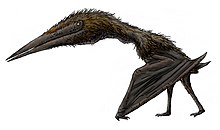Aerotitan
| Aerotitan Temporal range: Maastrichtian ~70 Ma PreꞒ Ꞓ O S D C P T J K Pg N ↓ | |
|---|---|
 | |
| Restoration of Aerotitan as an azhdarchid, following the original interpretation | |
| Scientific classification | |
| Domain: | Eukaryota |
| Kingdom: | Animalia |
| Phylum: | Chordata |
| Order: | †Pterosauria |
| Suborder: | †Pterodactyloidea |
| Family: | †Azhdarchidae |
| Genus: | †Aerotitan Novas et al. 2012 |
| Species: | †A. sudamericanus |
| Binomial name | |
| †Aerotitan sudamericanus Novas et al. 2012 | |
Aerotitan is a genus of large azhdarchid pterosaur known from the Late Cretaceous period (Maastrichtian stage) of what is now the Allen Formation of the Neuquén Basin in northern Patagonia, Argentina.[1]
Discovery and naming
The type species Aerotitan sudamericanus was named and described in 2012 by Fernando Novas, Martin Kundrat, Federico Agnolín, Martin Ezcurra, Per Erik Ahlberg, Marcelo Isasi, Alberto Arriagada and Pablo Chafrat. The generic name is derived from Greek ἀήρ, aer, "air", and Titan, in reference to the fact the species represents a large flying reptile. The specific name refers to its provenance from South America.[1]
The holotype, MPCN-PV 0054, has been recovered near the Bajo de Arriagada site, in Patagonia, from a layer of the upper Allen Formation. It consists, according to the original description, of a partial rostrum with a preserved length of 264 millimeters (10.4 in). This snout is elongated and transversely compressed and the jaws are toothless. The wingspan has been estimated as at least 5 meters (16 ft).[1]
In 2021, a study concluded that the specimen represented, not the upper jaws but the lower jaws.[2]
Taxonomy
Aerotitan has been assigned to the Azhdarchidae. If correct, this would make it the first unambiguous azhdarchid from South America.[1] A study published by Nicholas Longrich and colleagues in 2018 classified the genus as a thalassodromid, sister taxon to Alanqa (a pterosaur also assigned as an azhdarchid), however, such assignment is not well-supported.[3] The cladogram of their analysis is presented below:
| Dsungaripteromorpha |
| ||||||||||||||||||||||||
Conversely, a 2021 study by Rodrigo Pêgas and colleagues noted dissimilarities between it and thalassodromines and supported an azhdarchid identity.[2]
The cladogram below shows the placement of Aerotitan within Azhdarchiformes according to Andres, 2021:[4]
| Azhdarchiformes |
| ||||||||||||||||||||||||||||||||||||
See also
References
- ^ a b c d Novas, F. E.; Kundrát, M.; Agnolín, F. L.; Ezcurra, M. D.; Ahlberg, P. E.; Iasi, M. P.; Arriagada, A.; Chafrat, P. (2012). "A New Large Pterosaur from the Late Cretaceous of Patagonia". Journal of Vertebrate Paleontology. 32 (6): 1447–1452. doi:10.1080/02724634.2012.703979. hdl:11336/98097. JSTOR 23361061. S2CID 84340520.
- ^ a b Pêgas, R.V.; Holgado, B.; Ortiz David, L.D.; Baiano, M.A.; Costa, F.R. (August 21, 2021). "On the pterosaur Aerotitan sudamericanus (Neuquén Basin, Upper Cretaceous of Argentina), with comments on azhdarchoid phylogeny and jaw anatomy". Cretaceous Research. 129: Article 104998. doi:10.1016/j.cretres.2021.104998. ISSN 0195-6671. S2CID 238725853.
- ^ Longrich, Nicholas R.; Martill, David M.; Andres, Brian (2018). "Late Maastrichtian pterosaurs from North Africa and mass extinction of Pterosauria at the Cretaceous-Paleogene boundary". PLOS Biology. 16 (3): e2001663. doi:10.1371/journal.pbio.2001663. PMC 5849296. PMID 29534059.
- ^ Andres, Brian (2021). "Phylogenetic systematics of Quetzalcoatlus Lawson 1975 (Pterodactyloidea:Azhdarchoidea)". Journal of Vertebrate Paleontology. 41 (sup1): 203–217. doi:10.1080/02724634.2020.1801703. S2CID 245078533.
- v
- t
- e
| |||||||
|---|---|---|---|---|---|---|---|
| |||||||
|   | |||||||||||||||||||||||||||||||||||||||||
|   | |||||||||||||||||||||||||||||||||||||||||||||||
| 
 | |||||||||||||||||||||||||||||||||||||||||||||||||||||||||||||||||||||||||
| 
 | |||||||||||||||||||||||||||||||||||||||||||||||||||||||||||||||||||||||||||||||||||


















